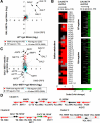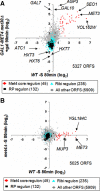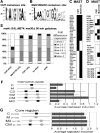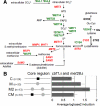Dissection of combinatorial control by the Met4 transcriptional complex
- PMID: 19940020
- PMCID: PMC2814790
- DOI: 10.1091/mbc.e09-05-0420
Dissection of combinatorial control by the Met4 transcriptional complex
Abstract
Met4 is the transcriptional activator of the sulfur metabolic network in Saccharomyces cerevisiae. Lacking DNA-binding ability, Met4 must interact with proteins called Met4 cofactors to target promoters for transcription. Two types of DNA-binding cofactors (Cbf1 and Met31/Met32) recruit Met4 to promoters and one cofactor (Met28) stabilizes the DNA-bound Met4 complexes. To dissect this combinatorial system, we systematically deleted each category of cofactor(s) and analyzed Met4-activated transcription on a genome-wide scale. We defined a core regulon for Met4, consisting of 45 target genes. Deletion of both Met31 and Met32 eliminated activation of the core regulon, whereas loss of Met28 or Cbf1 interfered with only a subset of targets that map to distinct sectors of the sulfur metabolic network. These transcriptional dependencies roughly correlated with the presence of Cbf1 promoter motifs. Quantitative analysis of in vivo promoter binding properties indicated varying levels of cooperativity and interdependency exists between members of this combinatorial system. Cbf1 was the only cofactor to remain fully bound to target promoters under all conditions, whereas other factors exhibited different degrees of regulated binding in a promoter-specific fashion. Taken together, Met4 cofactors use a variety of mechanisms to allow differential transcription of target genes in response to various cues.
Figures










Similar articles
-
A dominant suppressor mutation of the met30 cell cycle defect suggests regulation of the Saccharomyces cerevisiae Met4-Cbf1 transcription complex by Met32.J Biol Chem. 2008 Apr 25;283(17):11615-24. doi: 10.1074/jbc.M708230200. Epub 2008 Feb 28. J Biol Chem. 2008. PMID: 18308733 Free PMC article.
-
Characterizing the roles of Met31 and Met32 in coordinating Met4-activated transcription in the absence of Met30.Mol Biol Cell. 2012 May;23(10):1928-42. doi: 10.1091/mbc.E11-06-0532. Epub 2012 Mar 21. Mol Biol Cell. 2012. PMID: 22438580 Free PMC article.
-
Determinants of the ubiquitin-mediated degradation of the Met4 transcription factor.J Biol Chem. 2006 Apr 28;281(17):11744-54. doi: 10.1074/jbc.M600037200. Epub 2006 Feb 23. J Biol Chem. 2006. PMID: 16497670
-
A heteromeric complex containing the centromere binding factor 1 and two basic leucine zipper factors, Met4 and Met28, mediates the transcription activation of yeast sulfur metabolism.EMBO J. 1996 May 15;15(10):2519-29. EMBO J. 1996. PMID: 8665859 Free PMC article.
-
Metabolism of sulfur amino acids in Saccharomyces cerevisiae.Microbiol Mol Biol Rev. 1997 Dec;61(4):503-32. doi: 10.1128/mmbr.61.4.503-532.1997. Microbiol Mol Biol Rev. 1997. PMID: 9409150 Free PMC article. Review.
Cited by
-
Phylogenetic analysis of methionine synthesis genes from Thalassiosira pseudonana.Springerplus. 2015 Aug 4;4:391. doi: 10.1186/s40064-015-1163-8. eCollection 2015. Springerplus. 2015. PMID: 26251775 Free PMC article.
-
The Swi-Snf chromatin remodeling complex mediates gene repression through metabolic control.Nucleic Acids Res. 2023 Oct 27;51(19):10278-10291. doi: 10.1093/nar/gkad711. Nucleic Acids Res. 2023. PMID: 37650639 Free PMC article.
-
Coordinated regulation of sulfur and phospholipid metabolism reflects the importance of methylation in the growth of yeast.Mol Biol Cell. 2011 Nov;22(21):4192-204. doi: 10.1091/mbc.E11-05-0467. Epub 2011 Sep 7. Mol Biol Cell. 2011. PMID: 21900497 Free PMC article.
-
Genome-wide investigation of the role of the tRNA nuclear-cytoplasmic trafficking pathway in regulation of the yeast Saccharomyces cerevisiae transcriptome and proteome.Mol Cell Biol. 2013 Nov;33(21):4241-54. doi: 10.1128/MCB.00785-13. Epub 2013 Aug 26. Mol Cell Biol. 2013. PMID: 23979602 Free PMC article.
-
Transcriptional regulation in Saccharomyces cerevisiae: transcription factor regulation and function, mechanisms of initiation, and roles of activators and coactivators.Genetics. 2011 Nov;189(3):705-36. doi: 10.1534/genetics.111.127019. Genetics. 2011. PMID: 22084422 Free PMC article. Review.
References
-
- Ahmed Khan S., Zhang N., Ismail T., El-Moghazy A. N., Butt A., Wu J., Merlotti C., Hayes A., Gardner D. C., Oliver S. G. Functional analysis of eight open reading frames on chromosomes XII and XIV of Saccharomyces cerevisiae. Yeast. 2000;16:1457–1468. - PubMed
-
- Ausubel F., Brent R., Kingston R. E., Moore D. D., Seidman J. G., Smith J. A., Struhl K., editors. Short Protocols in Molecular Biology. 3rd Ed. New York: John Wiley & Sons; 1995.
-
- Bailey T. L., Elkan C. Fitting a mixture model by expectation maximization to discover motifs in biopolymers. Proceedings of the Second International Conference on Intelligent Systems for Molecular Biology; Menlo Park, CA: AAAI Press; 1994. pp. 28–36. - PubMed
-
- Bailey T. L., Gribskov M. Combining evidence using p-values: application to sequence homology searches. Bioinformatics. 1998;14:48–54. - PubMed
Publication types
MeSH terms
Substances
Grants and funding
LinkOut - more resources
Full Text Sources
Molecular Biology Databases

